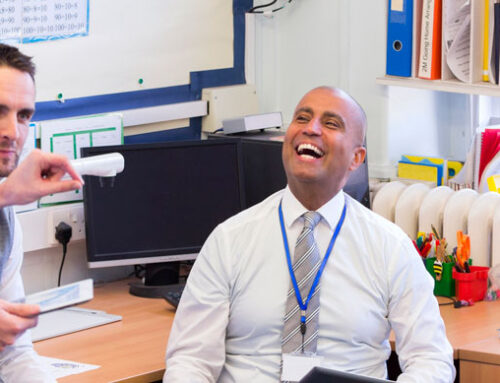As a school administrator or educator, you may be tasked with generating some staff meeting ideas for teachers. But you don’t want to create meetings just for the sale of meetings.
Staff or faculty meetings are a necessary part of any school. New information needs to be disseminated and discussed, and problems need to be solved. But so often, educators find themselves tuned out during meetings after a day of being “on” in the classroom. How can you make meetings engaging and actually useful?
The following ideas can help revive the traditional faculty meeting setting (no PowerPoint lectures, here!) and truly help educators in their primary goal, which is to help kids.
Strategy Share
You may often hear the term “best practices” thrown around, but so much of what educators are currently doing is working well. And yet they rarely have time to share strategies and brainstorm lesson ideas.
To allow for this, organize small groups by subject area, grade, or team. Educators could then share their effective strategies using sticky notes and poster paper, followed by a small-group discussion. If there is time, everyone could circulate and check out each poster. This activity is not only for collecting and sharing information; it is a springboard for a deeper discussion of what is working for kids who attend that specific school.
ENL Strategies for All Educators
Many educators are not adequately trained in supporting English Language Learners. English as a Second/New Language (ESL/ENL) goes far beyond simple translation. These students may have been in a vastly different educational setting. They may have had interrupted education, and they may be coming from traumatic situations. They may be leaving homes they love behind, and in most (if not all) cases, they are missing family members. There are many learning and SEL strategies, from increasing your wait time to fostering cultural responsiveness. ESL/ENL teachers are the experts and could share some of these strategies in an informal, small-group setting.
Special Education for All Educators
Regardless of your role within a school, every educator will work, at some point, with students who have IEPs or 504 plans. Some students are yet to be classified, and educators are often the ones to advocate for those students and work with families to get them the services they need. School psychologists, speech pathologists, and special education teachers are excellent resources for learning everything from how to properly read and implement an IEP, to effective and creative learning strategies. And, what educators tend to find is that methods used to help some students can end up helping all students.
Kid Talk
Educators know that what happens in a classroom is only a small part of meeting students’ needs. Students struggle with anxiety, depression, family dynamics, poverty, and many other challenges. A lot of times, the same issues come up again and again. And often educators are unsure of where to turn for support, especially during a busy school day.
Using faculty meeting time for a “kid talk” is an opportunity for further preparation and support. One way to organize this would be to split educators into small groups, assigning a counselor or social worker to each. Educators could then discuss difficulties they’re having, and brainstorm ideas for how to further support their students.
New Educator Welcome
Schools often assign mentors to new educators, and some districts even hold orientation sessions. Veteran teachers take new faculty members under their wings, showing them the ropes. And still, there are always more questions about everything from online grading systems to fire drill procedures that a handbook or a video tutorial just can’t answer. Taking faculty meeting time to welcome and support new educators contributes to a warm and helpful environment. This could be done a few times throughout the year, allowing veteran educators to rotate as the meeting facilitators.
Effective Problem-Solving
Educators are experts in their field; however, they are often not consulted about how to solve building-wide issues.Panorama Education is “a survey tool for administrators to collect professional feedback from teachers and staff.” SurveyMonkey is another anonymous tool that buildings could utilize to gather real, solution-driven information. When educators feel safe in conveying their concerns, real problem-solving can occur. Depending on the climate of the building, an open discussion of problems and solutions could be quite effective.
Check-In
Educators are reminded all too often that everything they do is “for the kids.” Teachers need to be given a voice and supported in their work. Using faculty time to have an informal discussion about how things are going could do wonders. Everyone, after all, wants and needs to be heard. It can be difficult to hear complaints, but it is important to be aware of problems in order to address them. A loose agenda with items such as concerns, ideas, and follow-up questions could assist in keeping the meeting on track and productive.
Things to Avoid…
- Using the full allotted time just because it’s there. If the meeting needs to go all the way to “contract time,” that’s fine. But it’s OK to dismiss faculty members when the objectives of the meeting are fulfilled!
- A PowerPoint/Google Slides presentation with a lecture. Educators know that direct instruction for an hour is ineffective; it’s certainly not going to work when they are the audience.
- Talking “at” faculty. Educators are professionals and deserve to be treated as such. Their input is as important as their ability to follow rules and protocols.
- Implementing anything that is not directly related to improving what educators do daily. No one wants to be forced to meditate or do yoga, instead of going home.
Don’t Be Afraid To..
- Use your own best practices! Granted, working with adults is different than working with children. But you are an expert in engaging and educating an audience.
- Keep it light. The more faculty members want to be there (even if they have to be), the more likely they are to contribute to a healthy, honest discussion of problem-solving approaches.
- Follow up! What questions still need to be answered? What are some next steps? Are there notes to be shared?
And remember, snacks are not a replacement for time wasted. But they will make an effective meeting even better.






